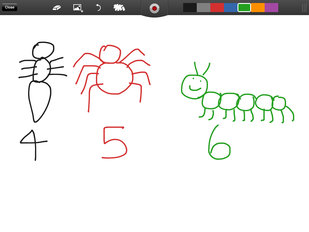Here’s what I learned:
A. I am a rescuer!!! I hate to see too many big junior primary eyes staring up at me pleading for a clue to begin somewhere!!
B. Too often I get caught up in the answers during Mental Routines and that’s why sometimes those golly MR’s seem like they are taking me forever to get through!!
So what’s my interpretation of this learning:
A. I think as I’ve gone down in the year levels (middle to junior primary) I’ve given my students less time for them to have to “cope” on their own (and I’ve also become a mum during that time too). I think my “mummy instinct” jumps in. At home I am remembering to make sure I give my kids enough time and opportunities to learn on their own how to tackle problems (like how to butter their toast) and this is what I have to do with my students at school.
B. I need to go back to my Mental Routines being a little bit ugly instead of being the rescuer–I think I am rescuing myself from feeling like I’ve failed if things get a bit too ugly instead of giving the kids an opportunity to learn themselves or through interactions with peers.
Now my action plan to build on this learning is:
A. I can remember being told on lots of occasions that kids need time to think. Each Tuesday and Thursday in our class we are going to provide problematized situations for the basis of our maths lessons. I think this will give the kids opportunities to build on the strategies that we learn through our mental routines, more collaborative learning and I’ll begin to see that not being a rescuer means I’m not hurting anyone either. We will be learners together.
B. In our class we have made a word wall – to keep a track of the new language that we’re introducing and to keep reminding me of the language to use. I am using timers to keep MR short and I will jot notes onto a whiteboard to remind myself for a MINI-lesson and not getting fussed about making an amazing anchor chart, but a useful and student lead/owned anchor chart.
A “quote” that I has played in my mind since our last session:
I can educate your child for yesterday or educate your child for tomorrow. If I educate your child for yesterday, they will not get a job.
A. I am a rescuer!!! I hate to see too many big junior primary eyes staring up at me pleading for a clue to begin somewhere!!
B. Too often I get caught up in the answers during Mental Routines and that’s why sometimes those golly MR’s seem like they are taking me forever to get through!!
So what’s my interpretation of this learning:
A. I think as I’ve gone down in the year levels (middle to junior primary) I’ve given my students less time for them to have to “cope” on their own (and I’ve also become a mum during that time too). I think my “mummy instinct” jumps in. At home I am remembering to make sure I give my kids enough time and opportunities to learn on their own how to tackle problems (like how to butter their toast) and this is what I have to do with my students at school.
B. I need to go back to my Mental Routines being a little bit ugly instead of being the rescuer–I think I am rescuing myself from feeling like I’ve failed if things get a bit too ugly instead of giving the kids an opportunity to learn themselves or through interactions with peers.
Now my action plan to build on this learning is:
A. I can remember being told on lots of occasions that kids need time to think. Each Tuesday and Thursday in our class we are going to provide problematized situations for the basis of our maths lessons. I think this will give the kids opportunities to build on the strategies that we learn through our mental routines, more collaborative learning and I’ll begin to see that not being a rescuer means I’m not hurting anyone either. We will be learners together.
B. In our class we have made a word wall – to keep a track of the new language that we’re introducing and to keep reminding me of the language to use. I am using timers to keep MR short and I will jot notes onto a whiteboard to remind myself for a MINI-lesson and not getting fussed about making an amazing anchor chart, but a useful and student lead/owned anchor chart.
A “quote” that I has played in my mind since our last session:
I can educate your child for yesterday or educate your child for tomorrow. If I educate your child for yesterday, they will not get a job.

 RSS Feed
RSS Feed